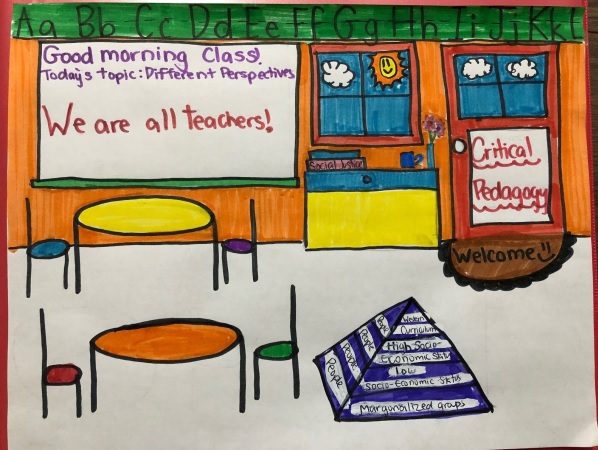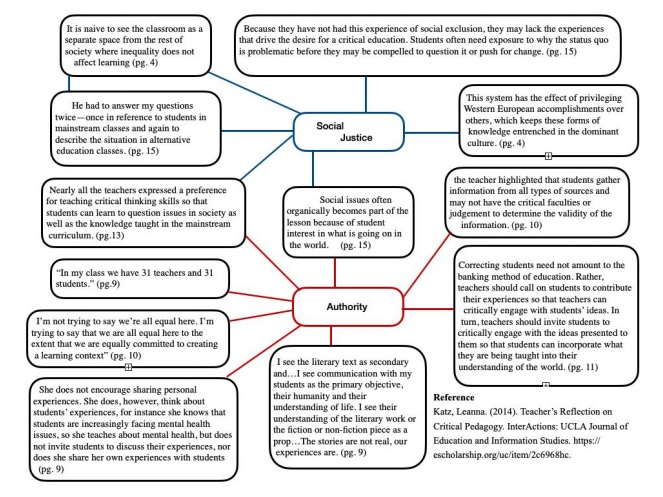In a Theoretical Frameworks of Education course in my first year of my Bachelor of Education Program, myself and a group of other students were task with researching and presenting on the topic of Critcal Pedagogy. Below is our handout as well as a link to the video of our presentation
Critical Pedagogy: Teachers’ Reflections on Critical Pedagogy in the Classroom
By ABC^2 (squared): Alexa Melnychuk, Braeman Meeker, Chloe Paterson, and Chris
Taylor
Link to our video:
https://www.youtube.com/watchv=SgSIqGCUY5M&ab_channel=ChristopherTAYLOR
- Summarizer/Visualizer:
Leanna Katz’s (2014) article “Teacher’s Reflections on Critical Pedagogy”
focuses on the purpose in understanding the motivating factors and reality of critical
pedagogy in Western world’s classrooms and curriculum. It goes into depth with
understanding critical pedagogy in a variety of different classrooms, where Katz
questions each individual teacher about their thoughts around critical pedagogy, and
how they choose to involve it in the classroom. Critical Pedagogy is used as a tool to
challenge: “what is rooted in what students know based on their daily lives” (Katz, 2014,
para. 7) and how to make the classroom inclusive and more diverse with the help of
students with different perspectives. This article asks the tough questions, and brings
perspective into the classroom, making teachers understand that their idea of using
critical pedagogy in the classroom may not be as inclusive as they think (Katz, 2014).
This ranges from allowing students to speak about some of their experiences: “ [t]his
teacher also noted that although the social science courses she teaches lend
themselves to integrating students’ experiences, she does not encourage sharing
personal experiences” (Katz, 2014, para, 28), to an opposite response of: “[i]n my class
we have 31 teachers and 31 students” (Katz, 2014, para 26). Katz challenges and looks
at diverse views from privilege, marginalization, low socio-economic status, and high
socio-economic status. Katz challenges readers and teachers to think about social
justice in the classroom through critical pedagogy perspective and diverse ways the
teachers use critical pedagogy in their classroom.
Reference
Katz, Leanna. (2014). Teacher’s Reflection on Critical Pedagogy. InterActions: UCLA
Journal of Education and Information Studies.
https://escholarship.org/uc/item/2c6968hc.

- Webber/Questioner

- In the article, one teacher recalls a time that one of her students read about
Holocaust denial online, and came to believe that the Holocaust did not
happen. She uses this as an example to demonstrate that students don’t
have the same judgement or critical thinking that a teacher has, and that
this is an example of why she is not in favour of student led classrooms. If
this was your class and you wanted to avoid shooting down students’
opinions, but also didn’t want to create a generation of Holocaust deniers,
how would you handle it?
I feel the teacher here sees this as problematic, but that it could also be looked at as an
opportunity to discuss how we can check the validity of sources, how conspiracy
theories work, and how to develop those critical thinking skills that children lack. - The article interviews several teachers, but how do students feel about
classes/assignments that display this sort of critical pedagogy? Since we
cannot interview students in the same way, how did you feel when you
experienced classes/assignments that focused on issues of social justice
or were more student led or both?
Personally, I haven’t experienced much of this in my education. We were very much on
the receptacle end of things. I can think back clearly on an assignment that might fall
into this though, when we were asked to form our own political parties and discuss what
issues were important to us. Many saw this as an opportunity to talk about marijuana
legalization, others saw it as a chance to make jokes like kicking Quebec out so we
didn’t have to do French anymore. Having said that, I do also recall productive
conversations coming out of it, and that I did feel more engaged with that lesson than
any of the ones that were simply lectures with note taking. - Wordsmith/Passage Picker
Three Words From The Article:
● Critical Pedagogy
○ Critical pedagogy is a teaching approach which attempts to help students
question and challenge domination, and the beliefs and practices that
dominate. In other words, it is a theory and practice of helping students
achieve critical consciousness.
○ “To avoid being overly reductive, I framed critical pedagogy as rooted in
what students know based on their daily lives. A critical education begins
with students exploring their concrete reality, sharing those experiences
and linking themselves to their socio-political context.” (Katz, 2014, p. 2).
○ In this context, we are seeing critical pedagogy as being able to mould our
teaching and lessons around the perceptions of our students. When we
take the time to get to learn the interests and experiences of our students,
we as teachers are able to think critically about what they already know
and then challenge them to think deeper about their opinions and
experiences.
● Banking Model
○ Defined as a banking model of education used by Paulo Freire to describe
and critique the traditional education system. The name refers to the
metaphor of students as containers into which educators must put
knowledge.
○ “With the banking model of education, students are passive recipients of
information that is detached from the context that gives it significance,
while teachers are a privileged voice responsible for imparting this
information.” (Katz, 2014, p. 3)
○ In this context, this model of teaching requires students to be open to
learning new forms of knowledge in different and new contexts. In order to
establish this, us as teachers need to find ways of keeping students
engaged and interested in the content. This traditional view can be
challenged by creating new methods of teaching and learning for students.
We as future teachers can create further teaching opportunities through
discussions with classmates and teachers, students teaching
students/teachers, and giving students a voice to hear new perspectives
from others.
● Receptacle
○ Defined as an object that is used to put things in or keep in
○ “This practice contrasts with the standard “banking” concept of education
where the teacher’s task is to fill the students who act as receptacles of
information (Freire, 1998, p. 67 as stated by Kratz, 2014, p. 3).
○ In this context, the word receptacle is being used to define students acting
as something in which they will retain and hold information. The
information given to students will be held in their minds and can be
brought out during different events or experiences. By giving students a
wide range of information on different topics, they are able to retain and
use that information to build more understanding in the future on that
given topic.
Paragraphs From The Article
“A critical education begins with students exploring their concrete reality,
sharing those experiences and linking themselves to their socio-political context.
Critical pedagogues like Paulo Freire, Ira Shor, Donaldo Macedo, and bell hooks
reason that by addressing issues that affect students’ daily lives, students
become more engaged with the ideas they are learning, thereby becoming more
critically conscious. Critical pedagogues also emphasize the importance of
teachers learning about the students—what their personal and work lives are like,
what their authentic language sounds like, what degree of alienation they have
experienced—and basing courses on students’ experiences (Florence, 1998;
Freire & Macedo, 1998; hooks, 1994; Shor & Freire, 1987 as stated by Kratz, 2014,
p. 2).
As future teachers, one of our main goals is to build positive relationships with
students alongside creating a safe learning environment. There are going to be many
cases where students use school as their only safe place where they can share ideas
and opinions. By allowing these forms of discussion, teachers can gain insight to
personal traits and lives of their students which can then be used to help create
meaningful and effective lesson plans and discussions. We felt that this passage fit with
some of our values as future teachers. The more we learn about our students, the more
we are able to understand their learning and topics that can spark interest to keep
students engaged. It is also important to note that when we learn about a student’s
socio-economic status for example, this can give insight to how they think about certain
topics and how informed they are. As students reach older ages, we can begin to
challenge them with giving opinions on more critical topics that relate to them. The goal
in these cases can be to have discussions and debates that can also give students a
teaching opportunity to teach others and the teacher. Finally, it is important to be
cautious of what we teach based on what we know about our students. If we know that
there are students who choose to not share details about their lives or have certain
behavioural triggers based on a topic, we may evaluate certain topics before giving the
go ahead in the classroom. Our goal is to make students feel safe, which again is why it
is important to get to know our students before teaching topics that could potentially
make some students not feel comfortable within the classroom or amongst their teacher
and peers.
“…challenging students’ ideas means engaging and working with them, whereas
exclusion does not invite students to become personally involved in the learning
process. Excluding students’ knowledge from classroom learning restricts the
possibility of a fuller, more profound education for both students and teachers.”
(Kratz, 2014, p. 10).
As future teachers, our role is to engage students to the best of our ability. By
being able to include all students in lessons, we are able to gain perspectives from their
point of view to a topic. When we hear multiple perspectives from students, the lesson
can have a deeper meaning and broaden their own knowledge and perspectives. By
creating opportunities to listen to the voices of all of our students, it will allow them to
teach one another, as well as teaching the teacher of viewpoints that might have not
been considered before. It is important to always be including all students and hearing
their knowledge. Subconsciously, we may tend to call on more students who participate
all the time compared to the students who sit back quietly and observe. In this case,
teachers need to be creative when finding ways of figuring out the pre existing
knowledge of their students. For example, schema activities or group discussions can
be a way of gaining an idea to pre existing knowledge and misconceptions. When we
create the opportunity to be open with one another, we can potentially see more
encouragement to open up about opinions and knowledge.
References:
Katz, Leanna. (2014). Teacher’s Reflection on Critical Pedagogy. InterActions: UCLA
Journal of Education and Information Studies.
https://escholarship.org/uc/item/2c6968hc.
Florence, N. (1998). bell hooks’ engaged pedagogy . Westport, CT: Greenwood
Publishing Group, INC.
Freire, P. (1998). “Chapter 2: The “Banking” Concept of Education.” In Freire, A. M., &
Macedo, D. (Eds.), The Paulo Freire Reader (67-79). New York: Continuum